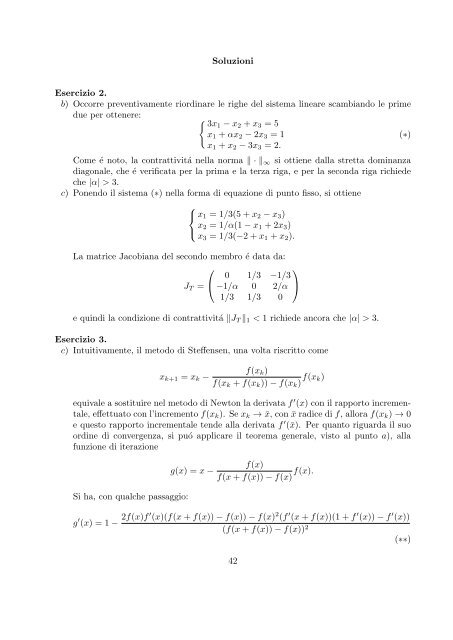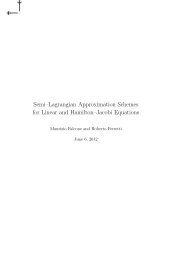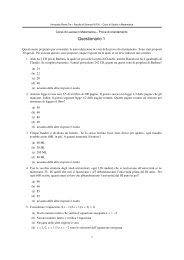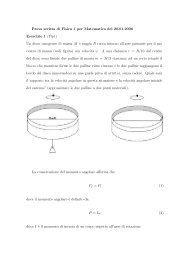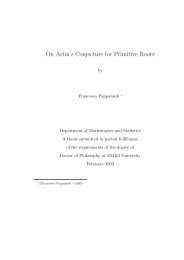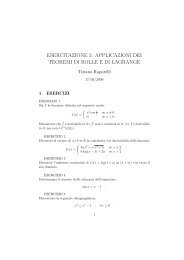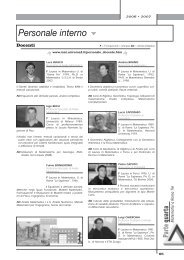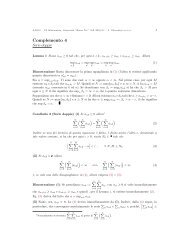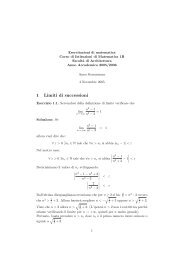- Page 1 and 2: Roberto FerrettiESERCIZI D’ESAMED
- Page 3 and 4: SoluzioniEsercizio 1.b) Se non vien
- Page 5 and 6: ESONERO DI ANALISI NUMERICA (AN3) -
- Page 7 and 8: Lo schema é quindi di secondo ordi
- Page 9 and 10: SoluzioniEsercizio 1.b) La fattoriz
- Page 11 and 12: SoluzioniEsercizio 1.a) La fattoriz
- Page 13 and 14: ESAME DI ANALISI NUMERICA (AN2) - 0
- Page 15 and 16: ESAME DI ANALISI NUMERICA (AN2) - 2
- Page 17 and 18: e quindi ben piú sfavorevole.Eserc
- Page 19 and 20: SoluzioniEsercizio 1.a) La necessit
- Page 21 and 22: ESONERO DI ANALISI NUMERICA (AN2) -
- Page 23 and 24: ESAME DI ANALISI NUMERICA (AN2) - 1
- Page 25 and 26: ESAME DI ANALISI NUMERICA (AN2) - 1
- Page 27 and 28: ESAME DI ANALISI NUMERICA (AN2) - 0
- Page 29 and 30: ESAME DI ANALISI NUMERICA (AN2) - 1
- Page 31 and 32: ESAME DI ANALISI NUMERICA (AN2) - 0
- Page 33 and 34: ESONERO DI ANALISI NUMERICA (AN3) -
- Page 35 and 36: ESONERO DI ANALISI NUMERICA (AN3) -
- Page 37 and 38: ESONERO DI ANALISI NUMERICA (AN2) -
- Page 39 and 40: ESONERO DI ANALISI NUMERICA (AN2) -
- Page 41: ESONERO DI ANALISI NUMERICA (AN1) -
- Page 45 and 46: SoluzioniEsercizio 2.a) Se [x k , x
- Page 47 and 48: ESAME DI ANALISI NUMERICA (AN1) - 1
- Page 49 and 50: dove si sono indicate rispettivamen
- Page 51 and 52: SoluzioniEsercizio 1.b) Occorre ver
- Page 53 and 54: SoluzioniEsercizio 1.c) L’equazio
- Page 55 and 56: ESAME DI ANALISI NUMERICA (AN1) - 0
- Page 57 and 58: ESONERO DI ANALISI NUMERICA (AN1) -
- Page 59 and 60: Nella fattorizzazione di Cholesky,
- Page 61 and 62: SoluzioniEsercizio 1.b) Le differen
- Page 63 and 64: ESAME DI ANALISI NUMERICA (AN1) - 0
- Page 65 and 66: La soluzione cercata é quindi data
- Page 67 and 68: SoluzioniEsercizio 3.c) Si ha Π 2
- Page 69 and 70: SoluzioniEsercizio 1.a) Il metodo d
- Page 71 and 72: che é soddisfatta a maggior ragion
- Page 73 and 74: SoluzioniEsercizio 2.c) Notiamo int
- Page 75 and 76: SoluzioniEsercizio 2.b) Si tratta d
- Page 77 and 78: ESAME DI ANALISI NUMERICA (AN1) - 2
- Page 79 and 80: ESAME DI ANALISI NUMERICA (AN2) - 2
- Page 81 and 82: ESAME DI ANALISI NUMERICA (AN2) - 1
- Page 83 and 84: ESONERO DI ANALISI NUMERICA (AN1) -
- Page 85 and 86: ESONERO DI ANALISI NUMERICA (AN1) -
- Page 87 and 88: é noto dalla teoria generale che l
- Page 89 and 90: SoluzioniEsercizio 1.b) Come é fac
- Page 91 and 92: ESAME DI ANALISI NUMERICA (AN1) - 1
- Page 93 and 94:
In particolare, per n = 3, 5, 7 si
- Page 95 and 96:
SoluzioniEsercizio 2.b) Ricordiamo
- Page 97 and 98:
ESONERO DI ANALISI NUMERICA (AN2) -
- Page 99 and 100:
ESONERO DI ANALISI NUMERICA (AN2) -
- Page 101 and 102:
e di conseguenza della Φ. Questo c
- Page 103 and 104:
SoluzioniEsercizio 1.a) Procedendo
- Page 105 and 106:
ESAME DI ANALISI NUMERICA (AN2) - 2
- Page 107 and 108:
ESAME DI ANALISI NUMERICA (AN2) - 1
- Page 109 and 110:
ESONERO DI ANALISI NUMERICA (AN1) -
- Page 111 and 112:
e la costante di contrazione richie
- Page 113 and 114:
SoluzioniEsercizio 2.c) Con sei cif
- Page 115 and 116:
ESAME DI ANALISI NUMERICA (AN1) - 1
- Page 117 and 118:
ESAME DI ANALISI NUMERICA (AN1) - 0
- Page 119 and 120:
ESAME DI ANALISI NUMERICA (AN2) - 0
- Page 121 and 122:
Se l’argomento del valore assolut
- Page 123 and 124:
SoluzioniEsercizio 1.b) Seguendo lo
- Page 125 and 126:
SoluzioniEsercizio 3.b) Si tratta d
- Page 127 and 128:
SoluzioniEsercizio 2.c) In un gener
- Page 129 and 130:
SoluzioniEsercizio 1.c) Nel caso in
- Page 131 and 132:
SoluzioniEsercizio 1.b) La approssi
- Page 133 and 134:
SoluzioniEsercizio 2.b) Poiché l
- Page 135 and 136:
SoluzioniEsercizio 2.b) Posto il me
- Page 137 and 138:
SoluzioniEsercizio 1.b) Si ha A = L
- Page 139 and 140:
SoluzioniEsercizio 1.a) La matrice
- Page 141 and 142:
ESONERO DI ANALISI NUMERICA (AN1) -
- Page 143 and 144:
ESONERO DI ANALISI NUMERICA (AN1) -
- Page 145 and 146:
ESAME DI ANALISI NUMERICA (AN1) - 1
- Page 147 and 148:
D’altra parte, si ha∣max |f ∣
- Page 149 and 150:
SoluzioniEsercizio 2.b) Definendo a
- Page 151 and 152:
SoluzioniEsercizio 1.b) La matrice
- Page 153 and 154:
SoluzioniEsercizio 1.b) La matrice
- Page 155 and 156:
ESONERO DI ANALISI NUMERICA (AN1) -
- Page 157 and 158:
ESONERO DI ANALISI NUMERICA (AN1) -
- Page 159 and 160:
ESAME DI ANALISI NUMERICA (AN1) - 0
- Page 161 and 162:
ESAME DI ANALISI NUMERICA (AN1) - 0
- Page 163 and 164:
ESAME DI ANALISI NUMERICA (AN1) - 2
- Page 165 and 166:
ESAME DI ANALISI NUMERICA (AN1) - 1
- Page 167 and 168:
Tenendo conto delle relazioni di si
- Page 169 and 170:
SoluzioniEsercizio 1.b) Al primo pa
- Page 171 and 172:
ESONERO DI ANALISI NUMERICA (AN1) -
- Page 173 and 174:
c) Dato per buono che, per simmetri
- Page 175 and 176:
SoluzioniEsercizio 2.b) Ovviamente
- Page 177 and 178:
SoluzioniEsercizio 1.b) La matrice
- Page 179 and 180:
SoluzioniEsercizio 2.b) Scrivendo i
- Page 181 and 182:
SoluzioniEsercizio 1.b) Si ha, dopo
- Page 183 and 184:
SoluzioniEsercizio 1.c) La funzione
- Page 185 and 186:
ESAME DI ANALISI NUMERICA (AN2) - 1
- Page 187 and 188:
ESAME DI ANALISI NUMERICA (AN1) - 0
- Page 189 and 190:
da cui si ottiene la maggiorazione
- Page 191 and 192:
SoluzioniEsercizio 3.b) Indicando c
- Page 193 and 194:
SoluzioniEsercizio 2.b) Il sistema
- Page 195 and 196:
SoluzioniEsercizio 1.b) Nella base
- Page 197 and 198:
ESAME DI ANALISI NUMERICA (AN1) - 1
- Page 199 and 200:
ESAME DI ANALISI NUMERICA (AN2) - 1
- Page 201 and 202:
ESAME DI ANALISI NUMERICA (AN1) - 0
- Page 203 and 204:
ESAME DI ANALISI NUMERICA (AN1) - 1
- Page 205 and 206:
ESAME DI ANALISI NUMERICA (AN2) - 1
- Page 207 and 208:
ESAME DI ANALISI NUMERICA (AN1) - 0
- Page 209 and 210:
ESONERO DI ANALISI NUMERICA (AN420)
- Page 211 and 212:
ESONERO DI ANALISI NUMERICA (AN420)
- Page 213 and 214:
ESAME DI ANALISI NUMERICA (AN420) -
- Page 215 and 216:
ESAME DI ANALISI NUMERICA (AN420) -
- Page 217 and 218:
ESAME DI ANALISI NUMERICA (AN420) -
- Page 219 and 220:
ESAME DI ANALISI NUMERICA (AN420) -
- Page 221 and 222:
ESONERO DI ANALISI NUMERICA (AN420)
- Page 223 and 224:
ESONERO DI ANALISI NUMERICA (AN420)
- Page 225 and 226:
ESAME DI ANALISI NUMERICA (AN420) -
- Page 227 and 228:
ESAME DI ANALISI NUMERICA (AN410) -
- Page 229 and 230:
ESAME DI ANALISI NUMERICA (AN420) -
- Page 231 and 232:
ESAME DI ANALISI NUMERICA (AN420) -
- Page 233 and 234:
ESONERO DI ANALISI NUMERICA (AN410)
- Page 235 and 236:
ESONERO DI ANALISI NUMERICA (AN410)
- Page 237 and 238:
ESAME DI ANALISI NUMERICA (AN420) -
- Page 239 and 240:
ESAME DI ANALISI NUMERICA (AN420) -
- Page 241:
ESAME DI ANALISI NUMERICA (AN420) -


